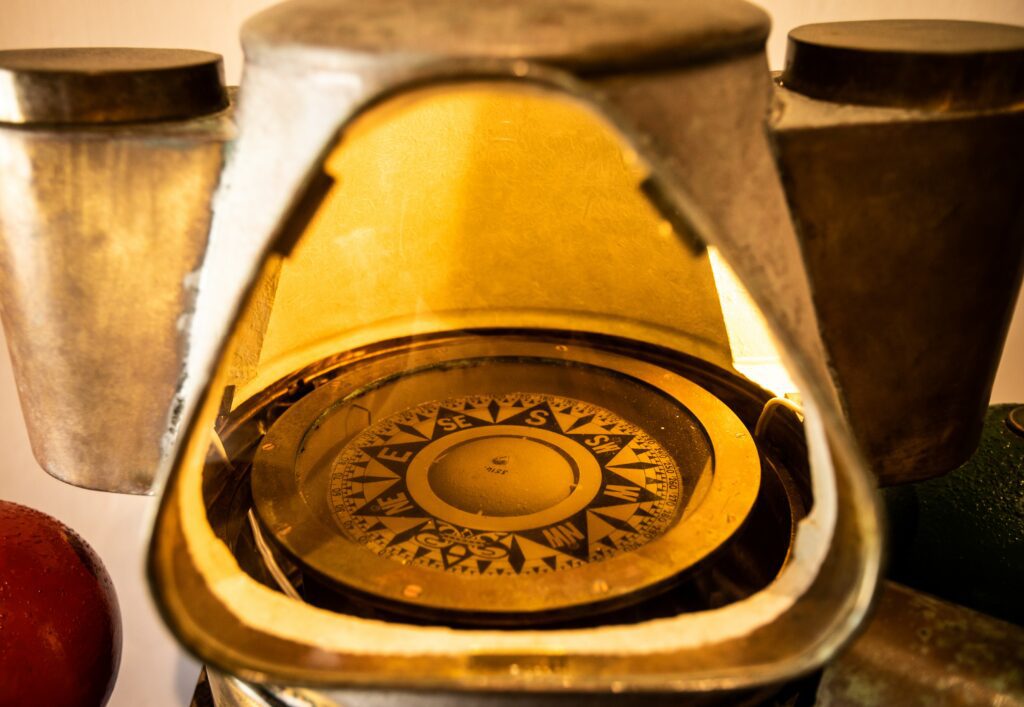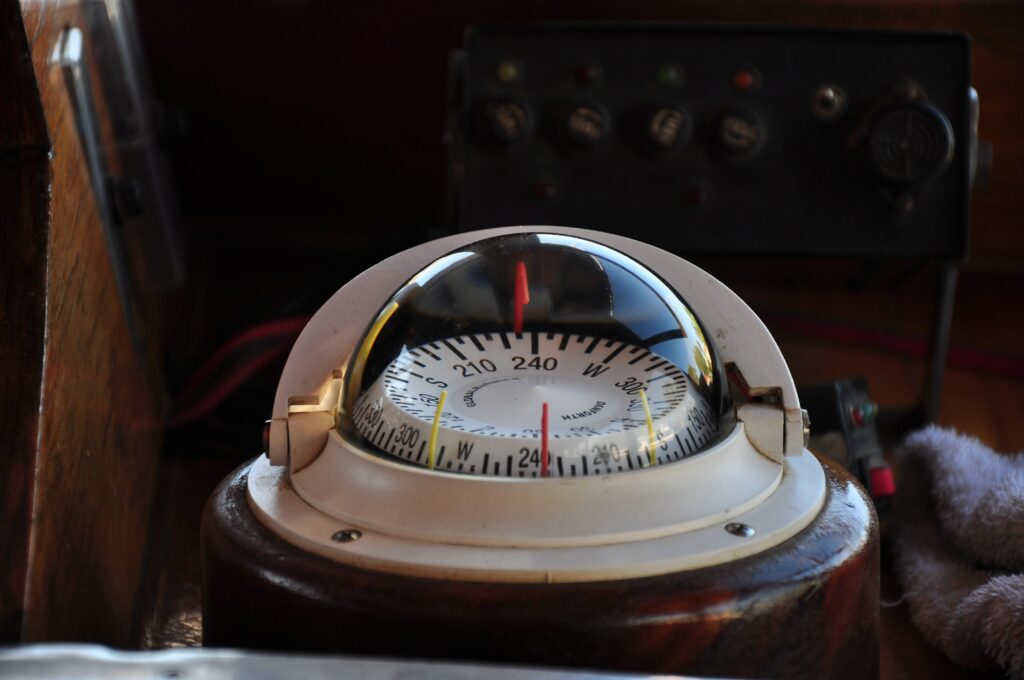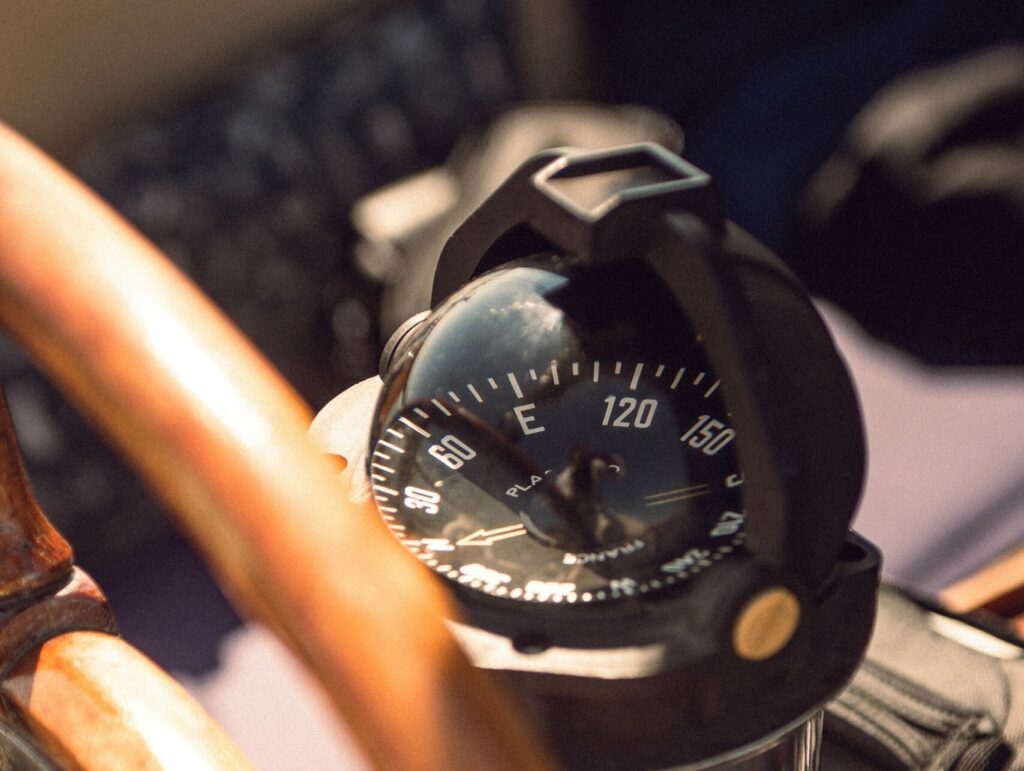An officer of the watch needs very important information during his watch and voyage. These are position and course/heading. The position, it is normally taken from the GPS equipment. For the course and heading, they can derive from either the gyrocompass or the magnetic compass. To get a reliable reading of the heading, magnetic compass maintenance and adjustment must be performed in the proper way and on good time.

Factors Affecting Magnetic Compass Performance
The performance of a magnetic compass can be affected by various factors. Here are some of the most common factors that can impact the accuracy of a magnetic compass:
- Deviation: Deviation refers to the difference between the magnetic compass reading and the true north. It is caused by the presence of magnetic fields within the vessel, such as those generated by electrical equipment or ferromagnetic materials.
- Variation: Variation is the angle between true north and magnetic north. It changes depending on the geographic location and the movement of the Earth’s magnetic field.
- Inclination: Inclination is the angle between the magnetic field and the horizontal plane. It changes depending on the geographic location and the movement of the Earth’s magnetic field.
- Interference: Interference occurs when external magnetic fields, such as those generated by other vessels or land-based sources, disrupt the magnetic compass.
- Mechanical errors: Mechanical errors can occur due to misalignment or damage to the compass, as well as errors in the design and manufacturing process.
- Human error: Human error can occur due to incorrect reading of the compass or failure to compensate for factors such as deviation and variation.
It is important to regularly monitor and adjust the magnetic compass to account for these factors and maintain its accuracy. This can help ensure safe navigation and prevent potential accidents or mishaps.
How To Adjust The Magnetic Compass?
Before one can adjust the magnetic compass, one needs to understand how it works. The magnetic compass which is located at the monkey bridge together with the radar scanner and communication equipment must not be confused with the gyrocompass which is located inside the bridge and mounted up with the steering of the ship.
The gyro repeaters that can be found on the wings of the vessel reflect the values of the gyro readings and not of the magnetic compass.
The main parts of the magnetic compass binnacle are the compass bowl mounted on gimbals which include the compass card that gives readings on bearings. It also includes port/starboard, and quadrantal correctors. The flinders bar houses magnets that are used to correct the compass. Lastly, there are the fore and athwartship magnets.
Before adjusting the compass itself, physical tests must be conducted to avoid time wasted. The competent person in port or even the officers on the bridge must make sure that all physical arrangements and connections are correct.

If the compass develops small bubbles, a compass fluid in the mixture of 55 percent distilled water and 45 percent grain alcohol can be added through the filling plug on the side of the compass bowl. The sealing gasket and filling gap itself must also be checked if an amount of liquid has leaked out to maintain the working condition of the compass.
The compass as per its manufacturer’s recommendation and schedule should be taken to a port facility, wherein it is far from magnetic influences for tests and sensibility. The tests conducted will indicate measurements on time of vibration and the ability of the compass card to return to the correct reading after being deflected. These will also include the pivot, jewel, and magnetic strength of the compass needles.
Next, residual magnetism must be checked on the flinders bar and spheres. Allow the spheres to move closer to the compass and slowly turn each sphere separately. Any observed deflection(more than two degrees) of the compass needles from this test concludes such magnetism on the spheres. If the ship is heading east or west, the officers may perform a flinders bar magnetization check.
The correct alignment of the gyro repeater, lubber’s line, and pelorus with the fore and aft line of the ship is of major importance. Misalignment will produce errors in the curve of deviations. This can be rectified by the use of an azimuth circle and by taking sight of the forward mast or objects near the centerline of the ship.
Magnetic Compass Maintenance
Solas regulations mandated all ships, irrespective of size, to carry a standard magnetic compass to check and correct the ship’s heading for differing variations and deviations worldwide.
This very important bridge equipment must be regularly checked to ensure its accurate operation. In the unfortunate event that the gyrocompass fails, the magnetic compass may be used to steer the ship.
The compass bowl must be filled with proper liquid to avoid bubbles forming and hampering the compass. Make sure the compass card is readable, centered in the correct position, and able to turn without friction to the glass. A small magnet placed on top of the glass could deflect the card and correct it to its true heading.
The quadrantal correctors or the sphere should be able to move in the provided groove and can be adjusted. It must be free from rust, grease, paint, or saltwater.

The bolts in the binnacle must be properly secured. Over time, as the vessel experiences vibrations, and sudden movement, the bolts, and screws may become loose. All correctors must be in the correct position/adjustment as recorded during the last inspection by a competent person or during dry-docking maintenance.
Make sure that the magnetic compass can be read and viewed easily for the steering position during daytime or nighttime navigation. Anything that hampers or hinders the OOW from getting a correct reading must be rectified immediately. At nighttime, lighting must be adequate to allow the bridge crew to read and record compass readings for logbook observation.
Importance of Magnetic Compass Maintenance
Maintaining a magnetic compass on board a ship is of utmost importance for safe navigation. A magnetic compass provides vital information such as the ship’s heading, course, and direction, which are essential for safe passage. It is important to note that in the event of a gyrocompass failure, the magnetic compass may be the only means of steering the ship.
To ensure that the magnetic compass is functioning correctly, regular maintenance and adjustment are necessary. This includes physical checks of the compass and its components, such as the compass bowl, quadrantal correctors, and flinders bar. Checking for residual magnetism, misalignment, and other factors that may affect the accuracy of the compass is crucial.
SOLAS regulations require all ships to carry a standard magnetic compass to correct the ship’s heading for different variations and deviations worldwide. The magnetic compass is also an essential backup instrument in case of electronic or mechanical failure. Therefore, its proper maintenance is essential to ensure that it is reliable when it is needed the most.
In addition to its importance in navigation, the magnetic compass is also a valuable historical artifact. It has been used for centuries and has played a crucial role in the development of maritime trade and exploration. Preserving and maintaining these instruments ensures that their historical significance is not lost and that they can continue to be used for generations to come.
In summary, the importance of magnetic compass maintenance cannot be overstated. A properly maintained and adjusted magnetic compass is critical to safe navigation, especially in the event of an electronic or mechanical failure. Therefore, regular maintenance and checks should be carried out to ensure that this vital instrument is functioning correctly.
How To Correct A Magnetic Compass?
To correct the magnetic compass properly, one needs to be familiar with the vessel’s heading, deviation, variation, and compass error. This would allow the officers to be well-versed in the nature of the compass and how to properly address any malfunction they may encounter.
The ship’s heading refers to the angle measured in degrees, clockwise from north to the ship’s fore and aft line relative to either true or magnetic meridian. When the true meridian is used as a reference, it is called the true heading. Magnetic heading is used when the magnetic meridian acts as a reference.
Variation differs at different locations around the globe. Local variations and their annual changes are indicated in the compass rose of a nautical chart. This is the angle difference between the true and magnetic meridian. Variation is said to be easterly when the magnetic meridian lies to the right of the true meridian and it becomes a westerly direction if it is located on the left side.
Deviation normally occurs as the ship’s magnetic influence will cause the compass needle to deflect from the magnetic meridian. The angle of deflection becomes easterly if the north end of the needle points east of the magnetic meridian and westerly if it is on the west part of the magnetic meridian. In summary, the sum of deviation and variation is the compass error.
The main objective of adjusting or correcting the compass is to reduce deviations and make the values of magnetic heading and compass heading identical or as near as practicable. There are two ways to adjust the compass, the magnetic heading, and the compass heading method. In the magnetic heading method, direct the heading of the ship to the magnetic heading and then adjust the compass heading to make the values the same.

This is the recommended method though it may be difficult to hold the ship steady while adjustments are being made. For the compass heading method, it may be easy to hold the ship steady but steering on an uncorrected compass may be a challenge as approximations are made during adjustment. If the gyrocompass has an error as well, make sure to apply it.
Another method is using the azimuths of the sun. Since the sun is easily identifiable and available at most times, it can be used for compass adjustment. This can be achieved by comparing the compass bearing of the sun and calculating the true bearing to get the compass error. Other celestial bodies like stars, moon, and planets may be considered but can be a challenge considering their poor visibility and varying times and declinations.
FAQs
What is the SOLAS requirement for magnetic compasses?
According to SOLAS (Safety of Life at Sea) regulations, all vessels are required to have at least one magnetic compass as a primary navigational instrument. The compass should be of a suitable type and size for the vessel and should be installed in a location that provides an accurate reading and is accessible to the navigator.
How often should a magnetic compass be adjusted?
The frequency of compass adjustment depends on various factors, including the vessel’s location, usage, and the age of the compass. It is generally recommended to have the compass checked and adjusted by a qualified technician at least once a year. However, if you notice any deviation or inaccuracy in the compass reading, you should have it checked immediately.
How do you care and maintain a magnetic compass?
To maintain the accuracy of the magnetic compass, you should avoid exposing it to strong magnetic fields, impact or shock, extreme temperatures, and moisture. You should regularly clean the compass and the surrounding area to prevent dust and debris from interfering with the readings. It is also important to ensure that the compass is properly lubricated and that the gimbal and bearings are in good condition.
How do you adjust a magnetic compass?
Compass adjustment should only be performed by a qualified technician using specialized equipment. The adjustment process involves compensating for the effects of the vessel’s magnetic fields and any deviation caused by the compass itself. The technician will adjust the deviation by adding or removing magnets from the compass, or by shifting the position of existing magnets.
What is the proper maintenance of a compass?
The proper maintenance of a compass includes regular cleaning, lubrication, and inspection for damage or wear. The compass should also be stored in a dry and secure location when not in use. It is important to avoid exposing the compass to extreme temperatures or moisture, which can cause rust or corrosion. Additionally, the compass should be checked and adjusted by a qualified technician at least once a year, or immediately if any deviation or inaccuracy is detected.
- Types of Gas Carriers as per IGC Code – April 22, 2025
- Wind-Assisted Propulsion Systems (WAPS): A Game Changer for Maritime Decarbonization – February 6, 2025
- 10 Boat Salvage Yards in California – January 25, 2025





Leave a Reply